Green Your Yard
Eco-friendly ways to transform your outdoor spaces
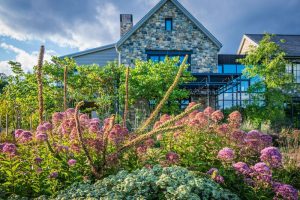
April has arrived, bringing promises of spring — longer days, warmer temps, blooming flowers. It also marks the arrival of Earth Day on the 22nd, reminding us of the urgent need to protect the planet.
As we spend more time outside, it’s the perfect time to take a moment to consider how our gardens, patios and yards can work with nature rather than against it. Even small changes can make a big difference in reducing your carbon footprint while still beautifying your yard. Win-win.
From choosing native plants that support local wildlife to environmentally conscious pools, there are plenty of ways to make your outdoor spaces more sustainable — this year and for years to come. Read on for tips and advice from local experts on how to transform your yard into an eco-friendly haven.
Artful Landscaping
One of the easiest ways to make your yard more eco-friendly is by adding greenery. That said, it isn’t as simple as heading to your local nursery and picking out the prettiest plants. Choosing the right plants for your space not only offers environmental benefits but also gives your garden the best opportunity to thrive — with less maintenance as a bonus.
First and foremost, opt for native plants over nonnative and try your best to avoid invasive species, like Bradford pear trees and Japanese barberry. Native plants offer “a host of benefits that enhance both the beauty and sustainability of your outdoor space,” said Dan Carl, founder and president of Arrowwood Landscape Design in West Chester. “These plants are well-suited to the local climate, requiring less water, weed control and maintenance, which makes them not only eco-friendly but also easier to care for. They improve soil health by promoting deep root systems that reduce erosion, sequester [capture] carbon and help manage stormwater. Moreover, native plants support local wildlife and pollinators, fostering a more biodiverse and vibrant ecosystem.”
Carl recommends combining low- maintenance native species like willow oak (Quercus phellos) and oakleaf hydrangea (Hydrangea quercifolia) with perennials like Arkansas blue star (Amsonia hubrichtii), coneflower (Echinacea) and prairie dropseed (Sporobolus heterolepis). “Grasses like switchgrass (Panicum virgatum) and flowers like blazing star (Liatris spicata) not only add movement and texture but also attract vital pollinators,” Carl said.
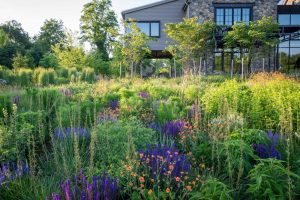
Donald Pell, owner of Donald Pell Gardens in Phoenixville, emphasized the importance of carefully planning your landscape design. “Learning to select the right plant for the right place is critical in making these gardens resilient. White oaks (Quercus alba) can be one of the most majestic trees in our landscape, but if they are planted in wet lowlands that hold water, the trees may decline and probably fail. However, its cousin, swamp white oak (Quercus bicolor), with its very similar stately habit will be right at home in these more hydric soils.”
Also, be thoughtful about where you plant. “Plants that soak up water and look lush and vibrant can be incorporated with beautifying plants that support pollinators and songbirds. Deciduous shade trees can be planted on the southern sides of homes or patios to provide a cooling effect,” said Pell. He also advises planting evergreens to the northwest to shield your home from cold winter winds.
Pool Options

As the weather warms, many of us fantasize about taking a dip in our very own swimming pool. Fortunately, there are ways to create the pool of your dreams while taking steps to minimize its impact on the planet.
When building your pool, consider alternatives to a traditional chlorine-based pool. For example, saltwater pools use salt to generate chlorine through a process called electrolysis, greatly reducing the need for harmful cleaning chemicals. Fewer chemicals in your pool means fewer pollutants in the surrounding ecosystem and on you as you swim.

Another option gaining popularity recently is natural swimming pools. These pools eliminate the need for chlorine entirely, relying on biological filtration systems like plants (water lilies, reeds, swamp hibiscus), gravel and natural microorganisms to keep the water clean. As an added bonus, the plants create a habitat for local wildlife, including birds, amphibians and insects.
Beyond chemical use, you can also reduce your pool’s environmental impact by choosing an energy-efficient pump. Did you know that a pool pump could be your home’s second-largest energy user? Tracy Bond, owner of Great Valley Pool Service in Frazer, recommends an Energy Star-labeled pump, such as the Pentair Intelliflo3. “By selling and servicing
energy-efficient pool pumps, we help customers save on energy costs while promoting sustainability, ensuring a cleaner, more eco-friendly pool experience for years to come,” she said.
Sustainable Materials
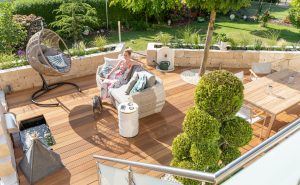
Many outdoor projects can be made more sustainable by using eco-friendly materials. Here are just a few ideas to get you started during your planning.
When building a new deck or patio, reclaimed wood is an excellent choice. Wood that’s been salvaged from old buildings, barns or other sources can give your project rustic charm while reducing the need for newly harvested timber, helping to conserve forests and minimize waste. Also consider finishing your wood with natural materials like tung oil or beeswax rather than synthetic varnishes. For a more modern look, opt for bamboo decking — a fast-growing, renewable resource that’s durable and weather-resistant.
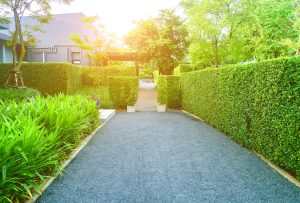
For those same reasons, reclaimed wood and bamboo are great options for fences. Alternatively, fencing made from recycled composite materials — made from plastic or wood fibers — are long-lasting and require minimal maintenance.
Or, for a truly “green” choice, consider a hedgerow of native trees or shrubs. Holly List, Penn State Extension Master Gardener, suggests river birch (Betula nigra), American holly (Ilex opaca) and red twig dogwood (Cornus sericea) to create a natural, and beautiful, barrier.
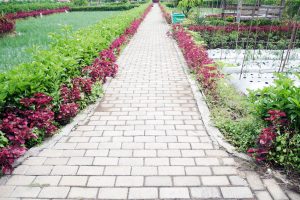
For pathways and driveways, permeable pavers are both environmentally friendly and functional. Made from porous concrete, asphalt or stone, these pavers allow rainwater to flow through, reducing stormwater runoff and recharging groundwater aquifers. Other sustainable options include locally sourced stone and reclaimed concrete pavers, which reduce your project’s carbon footprint by minimizing the transportation of new materials.
Finally, consider adorning your outdoor spaces with sustainable furniture. Furniture made from recycled or upcycled materials, such as aluminum, reclaimed wood and recycled plastic, are both durable and eco-friendly. Also look for pieces crafted from sustainably sourced materials like bamboo and teak, which are responsibly harvested and treated with natural finishes. Investing in high-quality, sustainable furniture not only enhances your space but also reduces waste by ensuring your furniture will last for years, reducing the need — and hassle — of replacing it.
The outdoor oasis of your dreams doesn’t have to come at the expense of nature. By making mindful choices — whether through sustainable materials, cleaner and greener pools, or native plants — you can create a backyard paradise that benefits both the environment and your lifestyle. With a bit of planning, you can transform your outdoor space into an eco-friendly retreat that you can feel proud and happy about for years to come.
Note: We’ve included the scientific names of plants, since native and nonnative species often have the same common name. Choose natives!
Further Reading
For more sustainable ways to spruce up your outdoor spaces, check out these articles from past issues of County Lines. Find them all on our website, CountyLinesMagazine.com.
- “Longing for Life Beyond the Lawn” by Blake Goll, Willistown Conservation Trust, September 2024
- “Backyard Bogs” by Nate Braddock, Jenkins Arboretum & Gardens, June 2024
- “Plant This, Not That” by Kirsten L. Werner, Natural Lands, August 2023
- “Native Plants for Resilient Gardens” by Stephanie Kuniholm, Jenkins Arboretum & Gardens, June 2023
- “This Spring, Add Some Biodiversity to Your Yard” by Monica McQuail, Willistown Conservation Trust, May 2023
Our Favorite Resources
- B&D Builders
- Ball & Ball
- Berk Hathaway Holly Gross
- Berk Hathaway Kit Anstey
- Berk Hathaway M. Schwartz
- Canvas Valley Forge
- Dewson Construction
- DiSabatino Landscaping
- King Construction
- McComsey Builders
- Monument/Sotheby’s Int’l
- Mostardi Nursery
- Mountaintop Construction
- Renewal Dynamics
- Sheller Energy
- White Horse Construction
